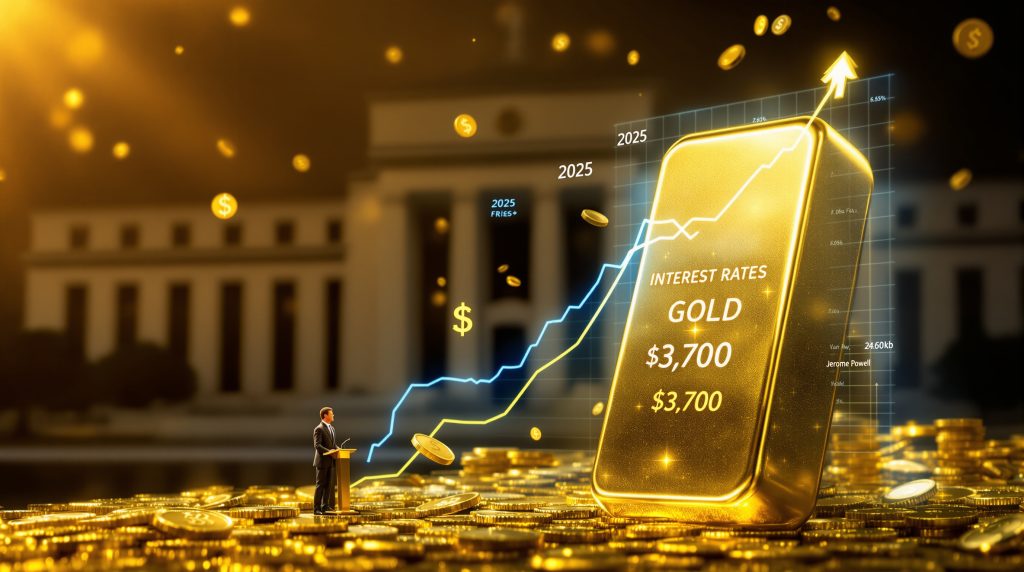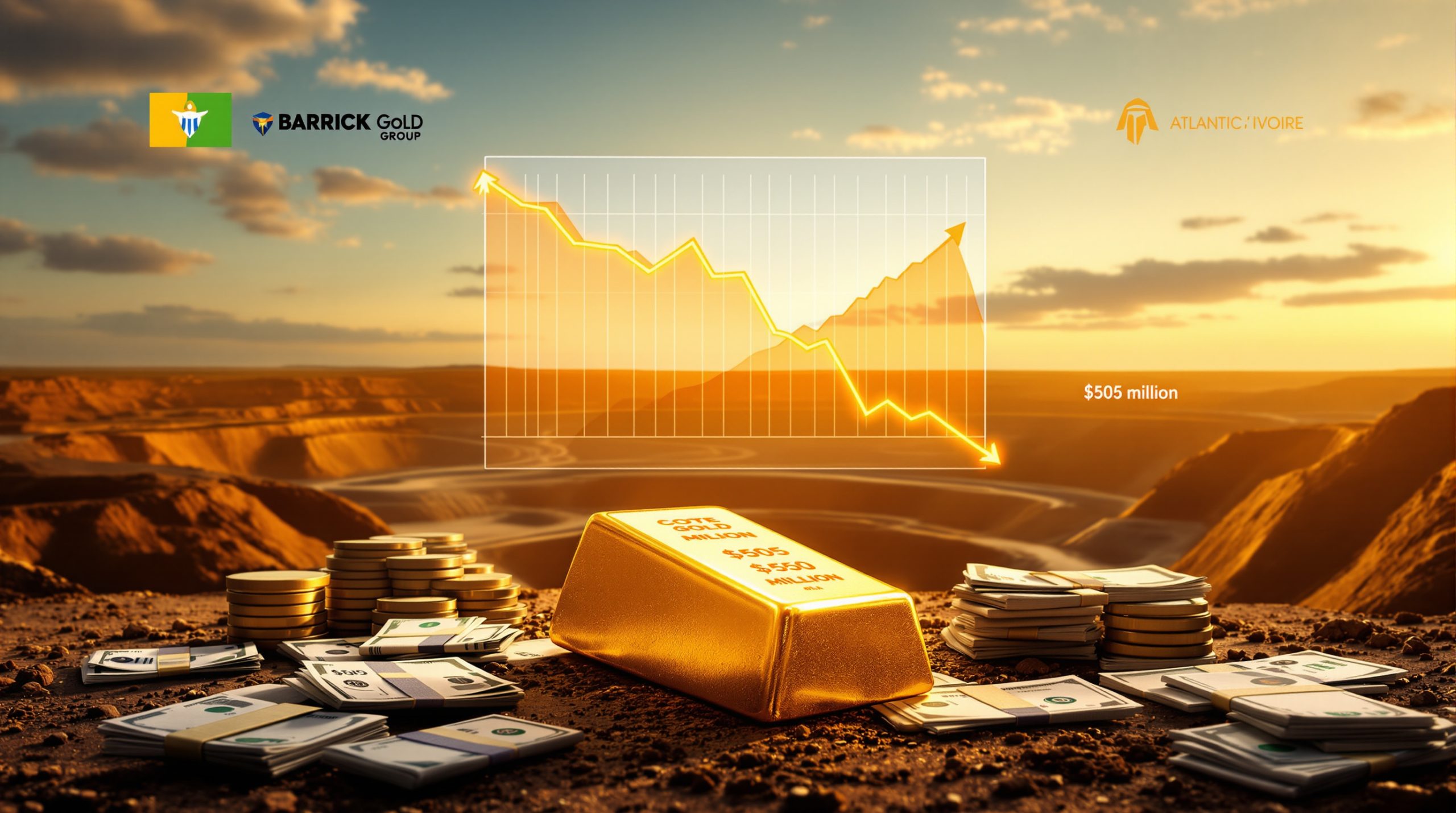Understanding Gold's Record-Breaking Performance in 2025
Gold has surged to unprecedented heights in 2025, breaking through significant psychological barriers and establishing new all-time highs. This remarkable rally represents a fundamental shift in market dynamics, driven by evolving monetary policy expectations and broader economic factors that have reshaped investor sentiment toward precious metals.
What's Driving Gold to All-Time Highs?
The yellow metal's impressive performance stems from a confluence of factors creating the perfect environment for bullish momentum. Investors have increasingly turned to gold amid economic uncertainty, evolving Federal Reserve policy, and persistent global tensions.
Gold's traditional role as a store of value has been amplified as market participants anticipate significant shifts in monetary policy. The metal's non-yielding nature becomes increasingly attractive when interest rates decline, positioning it as a preferred alternative to interest-bearing assets with diminishing returns.
The Current State of Gold Markets
Gold recently reached a historic peak of $3,702.95 per ounce, marking an unprecedented milestone in the precious metals market. Following this achievement, prices have experienced moderate consolidation as profit-taking emerged near these record-high gold prices analysis.
Despite occasional pullbacks, trading patterns reveal robust underlying momentum. Technical indicators suggest strong support levels have formed after each consolidation phase, indicating sustained buyer interest even at elevated price points.
Institutional interest continues to grow, with ETF holdings showing significant increases. The world's largest gold-backed exchange-traded fund recently reported a 0.32% rise in holdings to 979.95 metric tons, highlighting increased allocation to physical gold-backed securities among portfolio managers.
How Federal Reserve Interest Rate Decisions Impact Gold Prices
The relationship between Federal Reserve policy and gold performance represents one of the most critical correlations in financial markets. Understanding this dynamic provides essential context for the current gold rally and fed interest rates situation.
The Inverse Relationship Between Gold and Interest Rates
Gold typically demonstrates an inverse relationship with interest rates due to several fundamental economic mechanisms that influence its relative attractiveness as an investment asset.
Why Lower Rates Typically Boost Gold Prices
Reduced opportunity cost: When interest rates fall, the opportunity cost of holding non-yielding assets like gold decreases significantly. With lower returns from interest-bearing investments such as bonds and savings accounts, gold's lack of yield becomes less of a disadvantage.
Dollar weakness: Rate cuts often lead to a weaker US dollar, as lower yields make dollar-denominated assets less attractive to international investors. Since gold is priced in dollars globally, a weaker dollar makes gold more affordable for buyers using other currencies, potentially increasing demand.
Inflation concerns: Lower interest rates are often implemented to stimulate economic growth, which can eventually lead to higher inflation. Gold has historically served as an inflation hedge, preserving purchasing power when currency values erode.
Investment reallocation: During rate-cutting cycles, capital frequently flows from fixed-income assets toward alternative investments, including precious metals. This portfolio rebalancing can create sustained buying pressure for gold.
Historical Evidence of the Gold-Rate Relationship
Financial market history demonstrates clear patterns in gold's response to changing interest rate environments. During previous rate-cutting cycles, gold has typically appreciated significantly, with rallies often accelerating following the first cut in a new easing cycle.
Market data shows the magnitude of gold's response typically correlates with both the pace and extent of rate reductions. More aggressive cutting cycles generally produce stronger gold rallies, while gradual reductions tend to result in more measured advances.
What's Happening with the Fed's Current Monetary Policy?
The Federal Reserve's approach to monetary policy has become a central focus for gold investors seeking to anticipate market direction. Current Fed positioning represents a pivotal moment in the economic cycle.
September 2025 Federal Reserve Meeting Analysis
The Federal Reserve's September 2025 meeting has emerged as a crucial event for precious metals markets, with significant implications for near-term price action.
Current Market Expectations
Markets have coalesced around expectations for a 25 basis point rate cut at the September meeting, reflecting shifting economic priorities among Fed officials. This anticipated move represents an important inflection point after the previous tightening cycle.
Traders are pricing in potential additional cuts before year-end 2025, with Fed funds futures indicating a high probability (exceeding 95%) of continued monetary easing. This outlook has contributed substantially to gold market performance in recent months.
The trajectory of future rate adjustments remains a source of intense speculation. Investors are closely monitoring economic data releases for signals that might influence the pace of future reductions, with particular attention to inflation metrics and employment figures.
Powell's Communication Strategy
Federal Reserve Chair Jerome Powell's commentary following the September meeting will be scrutinized for nuanced signals about monetary policy direction. Market participants will focus on:
- Forward guidance regarding the potential pace of future rate adjustments
- Assessment of current labor market conditions and trends
- Inflation outlook and any expressed concerns about price stability
- The delicate balance between supporting employment and maintaining price stability
Powell's communication approach has evolved to emphasize data dependency while providing sufficient transparency to avoid market disruption. This balancing act significantly influences how rate decisions impact gold prices.
Why Has Gold Rallied Despite Unusual Market Conditions?
The 2025 gold rally and fed interest rates situation has defied some traditional market relationships, demonstrating resilience even when conventional correlations would suggest price weakness.
Atypical Factors in the Current Gold Bull Market
Several unconventional dynamics have characterized the current gold market environment, distinguishing this rally from historical patterns.
Divergence from Traditional Patterns
Gold has surged despite relatively modest dollar weakness, breaking from the typically strong inverse correlation between the metal and the US currency. This suggests other factors are outweighing currency effects in driving price action.
The rally has persisted through periods of surprisingly low market volatility, contrasting with gold's traditional role as a crisis hedge. Even with the VIX (market volatility index) at moderate levels, gold buying has remained robust.
Prices have advanced despite mixed economic data releases that would typically create headwinds for precious metals. This resilience indicates a structural shift in market perception regarding gold's role in modern portfolios.
Traditional correlations with other asset classes have temporarily weakened, with gold moving independently of equity market direction during several recent trading periods.
Unique Drivers of the Current Rally
Heightened speculative positioning in futures markets has reached notable levels, with non-commercial (speculative) long positions approaching multi-year highs according to CFTC data. This substantial interest from momentum-focused traders has amplified record surges in gold prices.
Political discourse surrounding central bank independence has intensified, with US President Donald Trump publicly calling for more aggressive rate cuts. These pressures have raised questions about monetary policy autonomy, enhancing gold's appeal as a politically neutral asset.
Structural shifts in global reserve asset allocation continue as central banks diversify holdings away from traditional currency reserves. This represents a long-term supportive factor that operates independently of short-term market fluctuations.
Persistent geopolitical uncertainties have maintained a baseline of safe-haven demand, creating a floor under prices even during brief corrective phases.
What Role Does the Labor Market Play in Gold's Performance?
Employment conditions significantly influence Federal Reserve policy decisions, creating an important indirect relationship with gold prices.
Employment Data's Influence on Fed Policy and Gold
The Federal Reserve's dual mandate makes labor market health a crucial consideration for monetary policy formulation, establishing a clear link to precious metals performance.
Current Labor Market Dynamics
Recent employment reports have shown increasing signs of cooling, with job creation figures trending below consensus expectations. This moderation follows the robust post-pandemic recovery period that saw exceptionally strong hiring.
Wage growth has gradually moderated from previous peaks, easing some inflation concerns while raising questions about consumer spending sustainability. This evolution in compensation trends provides the Fed with greater flexibility to implement accommodative policies.
The pace of job creation has demonstrably slowed compared to the post-pandemic recovery phase, though it remains positive. This transition toward more sustainable employment growth represents a delicate juncture for policymakers balancing inflation concerns against growth objectives.
Unemployment metrics remain central to Fed policy direction, with any significant deterioration likely to accelerate the pace of monetary easing—a scenario that would typically benefit gold prices.
How Employment Data Affects Gold Through the Fed
Weaker labor markets historically increase the likelihood of accommodative monetary policy, creating a more supportive environment for non-yielding assets like gold. This relationship explains gold investors' close attention to employment statistics.
Strong employment data could potentially limit the extent of anticipated rate cuts, creating a ceiling for gold's near-term upside. However, the market currently appears to be discounting this possibility based on recent price action.
The Federal Reserve's interpretation of labor statistics directly influences market sentiment toward gold, with Powell's characterization of employment trends often triggering immediate price reactions.
Unexpected employment trends frequently trigger significant gold price volatility, particularly when they challenge prevailing narrative about economic strength or weakness.
How Do Real Interest Rates Impact Gold Prices?
While nominal interest rates receive most media attention, real interest rates (adjusted for inflation) demonstrate a stronger historical correlation with gold performance.
The Critical Distinction Between Nominal and Real Rates
Real interest rates provide a more accurate measure of the opportunity cost of holding gold by accounting for the erosion of purchasing power through inflation.
Real Rate Dynamics and Gold Performance
Negative real rates create a particularly bullish environment for gold, as they indicate that inflation is outpacing nominal interest returns. This scenario effectively penalizes cash holdings and fixed-income investments while enhancing gold's relative attractiveness.
Treasury Inflation-Protected Securities (TIPS) yields offer valuable insights into market expectations for real rates. The relationship between TIPS yields and gold prices has historically been strong, with falling real yields correlating closely with rising gold prices.
Historical market data reveals numerous examples where gold prices rose despite rising nominal rates, particularly when inflation accelerated at a faster pace than interest rate increases. This underscores why focusing exclusively on Fed rate decisions without considering inflation can lead to incomplete analysis.
Current real rate trajectories suggest continued support for gold prices, as inflation-adjusted yields remain at levels historically conducive to precious metals strength.
Case Study: 1970s Gold Bull Market
The late 1970s presented a classic example of gold's response to real rate dynamics. During this period, gold prices soared from under $200 to over $800 per ounce despite rising nominal interest rates.
Federal Reserve Chairman Paul Volcker implemented aggressive interest rate hikes, eventually pushing rates above 15%. However, with inflation running at similar or higher levels, real rates remained negative for extended periods.
This historical precedent demonstrates why nominal rate movements alone provide insufficient context for gold market analysis. The current environment shares some parallels with this historical period, though with important structural differences in global markets.
What Are Professional Analysts Forecasting for Gold?
Leading financial institutions and commodity analysts have issued diverse projections for gold's future performance, reflecting varied interpretations of market conditions.
Expert Price Projections and Market Analysis
Professional forecasts provide valuable context for understanding potential price trajectories, though investors should recognize the inherent uncertainty in market predictions.
Price Targets and Timeline Projections
Several major global banks have projected gold reaching $4,000 per ounce by mid-2026, citing continued monetary policy accommodation and structural support from central bank purchases. These forecasts represent approximately 8-10% additional upside from current levels.
Technical analysts have identified key resistance levels near $3,750 and $3,850, with major support established around the $3,550 and $3,450 levels. These technical boundaries may influence short-term price action as the market consolidates recent gains.
Consensus views suggest potential price consolidation before further advances, with many analysts anticipating a period of range-bound trading to digest recent gains before establishing new highs.
Notable divergence exists regarding the sustainability of the current price trajectory, with some analysts cautioning about excessive speculative positioning while others emphasize fundamental factors supporting continued strength.
Risk Factors That Could Derail the Rally
Unexpectedly hawkish Federal Reserve policy shifts represent a primary risk to gold's uptrend. Any indication that rate cuts might be fewer or smaller than currently anticipated could trigger profit-taking.
Significant strengthening of the US dollar independent of interest rate expectations could pressure gold prices, particularly if driven by weakness in other major currencies.
Resolution of major geopolitical tensions would potentially reduce safe-haven demand, removing one supportive factor from the current market equation.
Substantial liquidation of speculative positions remains a technical risk, as positioning metrics indicate crowded long exposure that could unwind rapidly if sentiment shifts.
How Are Central Banks Influencing the Gold Market?
Central bank activity has emerged as a crucial factor in the gold market's supply-demand dynamics, with significant implications for long-term price trends.
Global Central Bank Purchasing Patterns
Central banks worldwide have transformed from net sellers to consistent net buyers of gold, fundamentally altering market structure over the past decade.
Recent Central Bank Acquisition Trends
Continued strong purchasing activity from emerging market central banks has provided substantial support to gold prices. Nations including China, Russia, India, and Turkey have systematically increased their gold reserves in recent years.
This trend reflects strategic diversification away from traditional reserve currencies, particularly the US dollar. Central banks have publicly acknowledged reducing dollar exposure while increasing precious metals allocations.
Strategic accumulation by major economic powers suggests long-term confidence in gold's monetary role despite its lack of yield. This behavior contrasts with previous decades when central banks were net sellers of gold reserves.
The impact of reserve asset reallocation extends beyond direct market effects, as it signals confidence in gold's long-term value proposition to other institutional investors.
Geopolitical Dimensions of Central Bank Gold Demand
De-dollarization initiatives across various regions have accelerated in response to geopolitical tensions and sanctions concerns. Gold represents a universally accepted reserve asset outside specific political control.
Strategic hedging against currency volatility has become increasingly important as monetary policies diverge among major economies. Gold provides insulation against currency devaluation risks that cannot be fully mitigated through diversification into other currencies.
Changing international monetary relationships have elevated gold's role as a neutral reserve asset. Nations seeking greater financial autonomy view gold holdings as enhancing monetary sovereignty.
These structural factors create long-term support for gold prices independent of cyclical economic factors or short-term interest rate movements.
What Should Investors Consider About Gold's Current Rally?
The unprecedented price levels reached during the current gold rally and fed interest rates situation present both opportunities and challenges for investors considering precious metals exposure.
Investment Implications and Strategic Considerations
Thoughtful portfolio positioning requires balancing gold's historical attributes against current market conditions and individual investment objectives.
Portfolio Allocation Strategies
Traditional allocation recommendations suggest maintaining 5-10% of portfolio assets in gold as a diversification tool. However, current market conditions have prompted some advisors to suggest temporarily higher allocations of 10-15% for investors concerned about monetary policy risks.
Balancing gold exposure with other asset classes remains essential for maintaining portfolio diversification. Even during strong gold bull markets, appropriate exposure to equities, bonds, and other alternative investments provides important risk management benefits.
Investors must choose between physical gold ownership (coins, bars), gold ETFs (offering convenience and liquidity), and mining equities (providing operational leverage to gold prices). Each approach carries distinct advantages and risk considerations.
The distinction between tactical and strategic positioning becomes particularly relevant at record price levels. Strategic investors typically maintain consistent allocations regardless of price, while tactical approaches may suggest reducing exposure after substantial rallies.
Technical Indicators and Market Sentiment
Current technical analysis reveals potential overbought conditions in short-term momentum indicators, suggesting the possibility of near-term consolidation before continued advances. The Relative Strength Index (RSI) has recently approached levels historically associated with temporary price corrections.
Sentiment metrics show elevated bullishness among retail investors, potentially serving as a contrarian indicator that warrants caution. Excessive optimism often precedes market corrections as new buyers become scarce.
Volume patterns during recent advances show strong participation, validating the rally's technical foundation. Healthy volume expansion during price increases suggests institutional involvement rather than speculative excess.
Market breadth within the precious metals complex appears robust, with silver and mining equities confirming gold's strength. This broad-based participation typically characterizes sustainable trends rather than transitory price spikes.
How Does Gold Compare to Other Precious Metals in This Environment?
Gold's rally has influenced the broader precious metals complex, though performance has varied significantly across different metals.
Relative Performance Analysis
Understanding the relationships between gold and other precious metals provides valuable context for sector allocation decisions.
Silver Market Dynamics
Silver prices have reached $41.98 per ounce, showing strong performance though with higher volatility than gold. This price level represents a significant recovery from previous years' trading ranges.
The gold-to-silver ratio (the number of silver ounces equivalent to one gold ounce) has decreased from historical highs but remains above long-term averages. This suggests potential additional upside for silver if historical relationships reassert themselves.
Silver's dual nature as both an industrial metal and investment asset creates unique market dynamics. While benefiting from the same monetary factors supporting gold, silver also responds to industrial demand trends, particularly in electronics, solar energy, and emerging technologies.
Price volatility in silver typically exceeds gold by a factor of 1.5-2x, offering higher potential returns during bull markets but greater downside risk during corrections. This volatility profile makes silver suitable for investors with higher risk tolerance.
Platinum Group Metals Performance
Platinum currently trades at $1,392.25 per ounce, showing more modest appreciation than gold or silver. This performance differential reflects platinum's greater dependency on industrial demand, particularly from the automotive sector.
Palladium prices at $1,182.17 per ounce represent a significant decrease from previous cycle highs, highlighting the metal's sensitivity to automotive production trends and technological shifts in catalytic converter manufacturing.
Industrial demand factors affect platinum group metals (PGMs) more directly than gold, making them less responsive to monetary policy shifts. Vehicle production rates, emissions regulations, and technological changes in the automotive sector often outweigh interest rate considerations.
The historical correlation between PGMs and gold typically weakens during periods dominated by monetary policy concerns, as observed in the current market environment.
What Are the Key Takeaways for Gold Investors?
Understanding gold's relationship with Federal Reserve policy requires recognizing several fundamental principles that guide market behavior.
Essential Insights for Market Participants
Successful navigation of gold markets demands awareness of multiple interrelated factors influencing price discovery.
Critical Factors to Monitor
Federal Reserve communication and policy trajectory remain primary drivers of gold market sentiment. Investors should focus not only on actual rate decisions but also on the accompanying statements and subsequent speeches by Fed officials.
Real interest rate trends provide more reliable guidance than nominal rates alone. Tracking the relationship between Treasury yields and inflation expectations offers valuable insights into gold's likely direction.
Labor market and inflation data releases warrant close attention as they directly influence Fed policy formulation. Unexpected developments in either area can trigger significant price movements.
Central bank purchasing patterns continue to provide structural support independent of short-term market fluctuations. Quarterly data on official sector activities helps quantify this important demand component.
Geopolitical developments affecting safe-haven demand can create temporary price surges or establish new baseline support levels. While difficult to predict, these factors require ongoing monitoring.
Long-Term Versus Short-Term Perspectives
Distinguishing between cyclical and secular trends helps investors maintain appropriate time horizons. The current gold bull market contains elements of both cyclical monetary policy support and longer-term structural changes in global reserve management.
Historical context remains essential for evaluating current price levels. While nominal prices have reached record highs, inflation-adjusted prices remain below previous cycle peaks when measured in constant dollars.
Potential catalysts for the next major price move include unexpected shifts in Fed policy guidance, significant changes in inflation expectations, or escalation of geopolitical tensions. These trigger events typically initiate new trading ranges.
Risk management considerations become increasingly important at record price levels. Position sizing, stop-loss placement, and profit-taking strategies deserve careful attention when markets extend into uncharted territory.
Frequently Asked Questions About Gold and Interest Rates
Why does gold typically rise when interest rates fall?
Gold pays no interest or dividends, making it more competitive when yields on interest-bearing assets decline. This reduced opportunity cost enhances gold's relative attractiveness within diversified portfolios. Additionally, lower rates often weaken the US dollar, making gold more affordable for international buyers and potentially stimulating inflation concerns, which enhance gold's appeal as a store of value.
How much further could gold prices rise if the Fed continues cutting rates?
While predictions vary considerably, several major financial institutions project gold could reach $4,000 per ounce by mid-2026 if the Federal Reserve maintains an easing cycle. However, this relationship isn't automatic—factors such as the pace of cuts, inflation trends, and geopolitical developments will influence the magnitude of any advance. Historical precedent suggests that extended easing cycles typically support multi-year gold bull markets.
What would cause gold prices to decline despite Fed rate cuts?
Several scenarios could pressure gold despite rate cuts: a significant strengthening of the US dollar for other reasons (such as weakness in alternative currencies), substantial liquidation of speculative positions following an extended rally, resolution of major geopolitical tensions reducing safe-haven demand, or if rate cuts are perceived as insufficient to prevent broader economic weakness that triggers liquidation across multiple asset classes.
How do real interest rates differ from the Fed's nominal rates?
Real interest rates represent nominal rates adjusted for inflation. For example, if the Fed funds rate is 3% but inflation is 4%, the real interest rate is -1%. Negative real rates create a particularly supportive environment for gold, as they erode the purchasing power of cash and fixed-income investments. Gold has historically performed strongly during periods of negative real rates, even when nominal rates were rising.
Should investors consider gold at current record price levels?
Investment decisions should reflect individual circumstances, risk tolerance, and portfolio objectives. While gold at record levels may cause hesitation, many advisors suggest maintaining strategic allocations rather than attempting to time market tops and bottoms. According to recent CNBC analysis, current conditions that favor gold include negative real interest rates, currency debasement concerns, and geopolitical uncertainties. Investors might consider dollar-cost averaging into positions rather than making large one-time allocations at record prices.
Ready to Capitalise on the Next Major Mineral Discovery?
Discover the power of real-time alerts on significant ASX mineral discoveries through Discovery Alert's proprietary Discovery IQ model, providing you with actionable investment insights before the broader market. Visit our discoveries page to understand how historic mineral discoveries have generated substantial returns for early investors.




